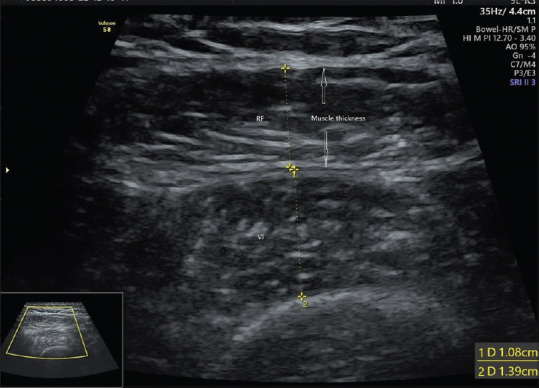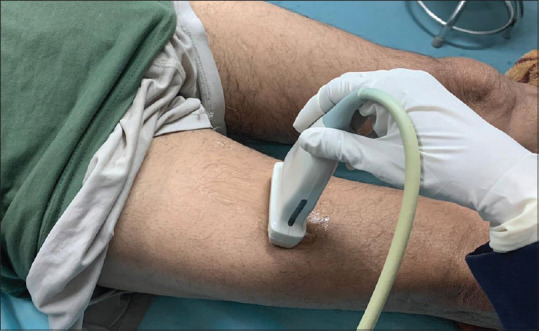超声检查评估肌萎缩:一个初步研究。
IF 1.2
Q3 OBSTETRICS & GYNECOLOGY
引用次数: 0
摘要
人类骨骼肌通过维持活动能力、平衡和代谢稳态,在保持健康方面发挥着关键作用。作为衰老的一部分,严重的肌肉损失并因疾病而加速,导致肌肉减少症,这成为老年人生活质量的重要预测因素。因此,通过精确的定性和定量测量骨骼肌质量(MM)和功能来进行少肌症的临床筛查和验证是转化研究的中心阶段。有许多成像模式可用,每种成像模式都有其优势和局限性,无论是在解释、技术过程、时间限制还是费用方面。B超(US)是一种比较新颖的评估肌肉的方法。它可以同时测量多个参数,如MM和结构,包括肌肉厚度、横截面积、回声、三角角和束长度。它还可以评估肌肉收缩力和肌肉微循环等动态参数。由于在诊断少肌症的标准化和诊断阈值方面缺乏共识,美国尚未获得全球关注。然而,这是一种廉价且广泛可用的具有临床应用性的技术。超声导出的参数与强度和功能能力良好相关,并提供潜在的预后信息。我们的目的是介绍这项有前景的技术在少肌症中的循证作用、其相对于现有模式的优势及其在实际实践中的局限性,希望它能成为社区诊断少肌症的“听诊器”。本文章由计算机程序翻译,如有差异,请以英文原文为准。



Ultrasonography for Assessment of Sarcopenia: A Primer.
ABSTRACT The human skeletal muscle has a pivotal role in preserving health by maintaining mobility, balance, and metabolic homeostasis. Significant muscle loss as a part of aging and accelerated by disease leads to sarcopenia which becomes an important predictor of quality of life in older persons. Therefore, clinical screening for sarcopenia and validation by precise qualitative and quantitative measurement of skeletal muscle mass (MM) and function is at the center-stage of translational research. Many imaging modalities are available, each having their strengths and limitations, either in interpretation, technical processes, time constraints, or expense. B-mode ultrasonography (US) is a relatively novel approach to evaluating muscle. It can measure several parameters such as MM and architecture simultaneously including muscle thickness, cross-sectional area, echogenicity, pennate angle, and fascicle length. It can also evaluate dynamic parameters like muscle contraction force and muscle microcirculation. US has not gained global attention due to a lack of consensus on standardization and diagnostic threshold values to diagnose sarcopenia. However, it is an inexpensive and widely available technique with clinical applicability. The ultrasound-derived parameters correlate well with strength and functional capacity and provide potential prognostic information. Our aim is to present an update on the evidence-based role of this promising technique in sarcopenia, its advantages over the existing modalities, and its limitations in actual practice with the hope that it may emerge as the “stethoscope” for community diagnosis of sarcopenia.
求助全文
通过发布文献求助,成功后即可免费获取论文全文。
去求助
来源期刊

Journal of Mid-life Health
Social Sciences-Health (social science)
CiteScore
1.70
自引率
9.10%
发文量
39
审稿时长
43 weeks
期刊介绍:
Journal of mid-life health is the official journal of the Indian Menopause society published Quarterly in January, April, July and October. It is peer reviewed, scientific journal of mid-life health and its problems. It includes all aspects of mid-life health, preventive as well as curative. The journal publishes on subjects such as gynecology, neurology, geriatrics, psychiatry, endocrinology, urology, andrology, psychology, healthy ageing, cardiovascular health, bone health, quality of life etc. as relevant of men and women in their midlife. The Journal provides a visible platform to the researchers as well as clinicians to publish their experiences in this area thereby helping in the promotion of mid-life health leading to healthy ageing, growing need due to increasing life expectancy. The Editorial team has maintained high standards and published original research papers, case reports and review articles from the best of the best contributors both national & international, consistently so that now, it has become a great tool in the hands of menopause practitioners.
 求助内容:
求助内容: 应助结果提醒方式:
应助结果提醒方式:


